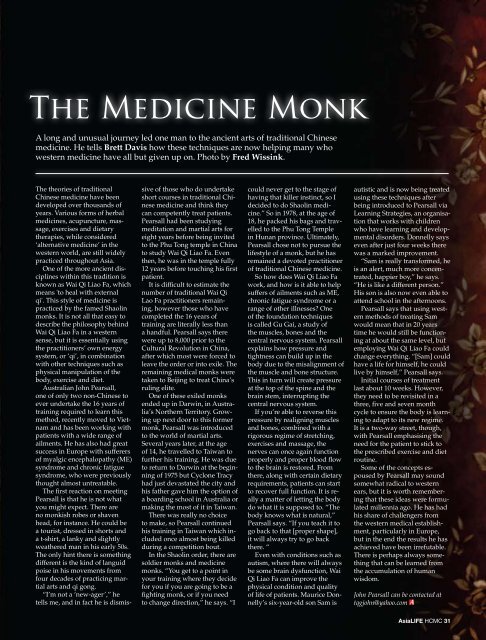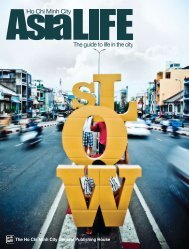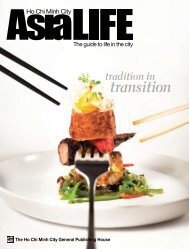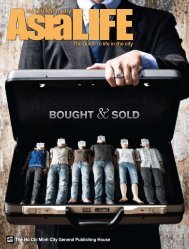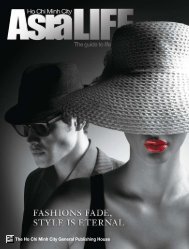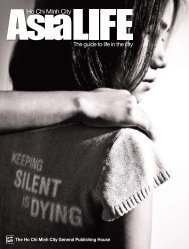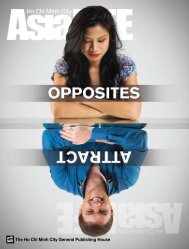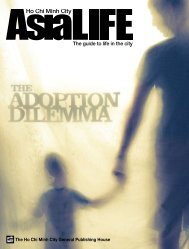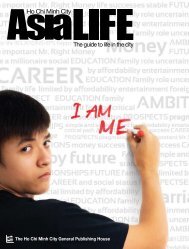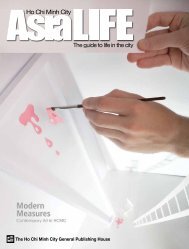You also want an ePaper? Increase the reach of your titles
YUMPU automatically turns print PDFs into web optimized ePapers that Google loves.
The Medicine MonkA long and unusual journey led one man to the ancient arts of traditional Chinesemedicine. He tells Brett Davis how these techniques are now helping many whowestern medicine have all but given up on. Photo by Fred Wissink.The theories of traditionalChinese medicine have beendeveloped over thousands ofyears. Various forms of herbalmedicines, acupuncture, massage,exercises and dietarytherapies, while considered‘alternative medicine’ in thewestern world, are still widelypracticed throughout Asia.One of the more ancient disciplineswithin this tradition isknown as Wai Qi Liao Fa, whichmeans 'to heal with externalqi'. This style of medicine ispracticed by the famed Shaolinmonks. It is not all that easy todescribe the philosophy behindWai Qi Liao Fa in a westernsense, but it is essentially usingthe practitioners’ own energysystem, or ‘qi’, in combinationwith other techniques such asphysical manipulation of thebody, exercise and diet.Australian John Pearsall,one of only two non-Chinese toever undertake the 16 years oftraining required to learn thismethod, recently moved to Vietnamand has been working withpatients with a wide range ofailments. He has also had greatsuccess in Europe with sufferersof myalgic encephalopathy (ME)syndrome and chronic fatiguesyndrome, who were previouslythought almost untreatable.The first reaction on meetingPearsall is that he is not whatyou might expect. There areno monkish robes or shavenhead, for instance. He could bea tourist, dressed in shorts anda t-shirt, a lanky and slightlyweathered man in his early 50s.The only hint there is somethingdifferent is the kind of languidpoise in his movements fromfour decades of practicing martialarts and qi gong.“I’m not a ‘new-ager’,” hetells me, and in fact he is dismissiveof those who do undertakeshort courses in traditional Chinesemedicine and think theycan competently treat patients.Pearsall had been studyingmeditation and martial arts foreight years before being invitedto the Phu Tong temple in Chinato study Wai Qi Liao Fa. Eventhen, he was in the temple fully12 years before touching his firstpatient.It is difficult to estimate thenumber of traditional Wai QiLao Fa practitioners remaining,however those who havecompleted the 16 years oftraining are literally less thana handful. Pearsall says therewere up to 8,000 prior to theCultural Revolution in China,after which most were forced toleave the order or into exile. Theremaining medical monks weretaken to Beijing to treat China’sruling elite.One of these exiled monksended up in Darwin, in Australia’sNorthern Territory. Growingup next door to this formermonk, Pearsall was introducedto the world of martial arts.Several years later, at the ageof 14, he travelled to Taiwan tofurther his training. He was dueto return to Darwin at the beginningof 1975 but Cyclone Tracyhad just devastated the city andhis father gave him the option ofa boarding school in Australia ormaking the most of it in Taiwan.There was really no choiceto make, so Pearsall continuedhis training in Taiwan which includedonce almost being killedduring a competition bout.In the Shaolin order, there aresoldier monks and medicinemonks. “You get to a point inyour training where they decidefor you if you are going to be afighting monk, or if you needto change direction,” he says. “Icould never get to the stage ofhaving that killer instinct, so Idecided to do Shaolin medicine.”So in 1978, at the age of18, he packed his bags and travelledto the Phu Tong Templein Hunan province. Ultimately,Pearsall chose not to pursue thelifestyle of a monk, but he hasremained a devoted practitionerof traditional Chinese medicine.So how does Wai Qi Liao Fawork, and how is it able to helpsuffers of ailments such as ME,chronic fatigue syndrome or arange of other illnesses? Oneof the foundation techniquesis called Gu Gai, a study ofthe muscles, bones and thecentral nervous system. Pearsallexplains how pressure andtightness can build up in thebody due to the misalignment ofthe muscle and bone structure.This in turn will create pressureat the top of the spine and thebrain stem, interrupting thecentral nervous system.If you’re able to reverse thispressure by realigning musclesand bones, combined with arigorous regime of stretching,exercises and massage, thenerves can once again functionproperly and proper blood flowto the brain is restored. Fromthere, along with certain dietaryrequirements, patients can startto recover full function. It is reallya matter of letting the bodydo what it is supposed to. “Thebody knows what is natural,”Pearsall says. “If you teach it togo back to that [proper shape],it will always try to go backthere. “Even with conditions such asautism, where there will alwaysbe some brain dysfunction, WaiQi Liao Fa can improve thephysical condition and qualityof life of patients. Maurice Donnelly’ssix-year-old son Sam isautistic and is now being treatedusing these techniques afterbeing introduced to Pearsall viaLearning Strategies, an organisationthat works with childrenwho have learning and developmentaldisorders. Donnelly sayseven after just four weeks therewas a marked improvement.“Sam is really transformed, heis an alert, much more concentrated,happier boy,” he says.“He is like a different person.”His son is also now even able toattend school in the afternoons.Pearsall says that using westernmethods of treating Samwould mean that in 20 yearstime he would still be functioningat about the same level, butemploying Wai Qi Liao Fa couldchange everything. “[Sam] couldhave a life for himself, he couldlive by himself,” Pearsall says.Initial courses of treatmentlast about 10 weeks. However,they need to be revisited in athree, five and seven monthcycle to ensure the body is learningto adapt to its new regime.It is a two-way street, though,with Pearsall emphasising theneed for the patient to stick tothe prescribed exercise and dietroutine.Some of the concepts espousedby Pearsall may soundsomewhat radical to westernears, but it is worth rememberingthat these ideas were formulatedmillennia ago. He has hadhis share of challengers fromthe western medical establishment,particularly in Europe,but in the end the results he hasachieved have been irrefutable.There is perhaps always somethingthat can be learned fromthe accumulation of humanwisdom.John Pearsall can be contacted attqgjohn@yahoo.comasialife HCMC 31


